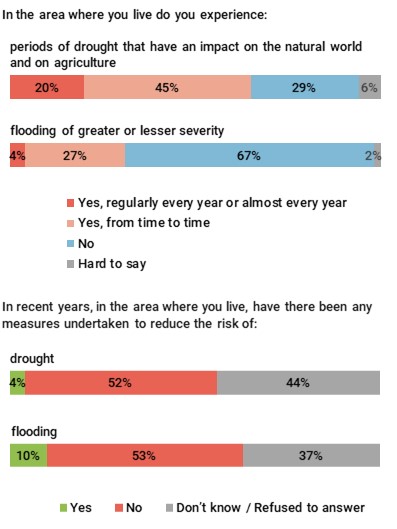31/2021
2021-10-01
Flooding and Drought in Poland
From the responses of the people surveyed, it is clear that periods of drought with an impact on both the natural world and agriculture, are a greater problem in Poland than flooding. Most respondents had experienced droughts in the areas where they lived, while for one in five this was a regular occurrence every year, or almost. On the other hand, not quite a third of respondents had been affected by flooding and very few regularly. In addition, most of those living in areas prone to droughts were certain that in recent years these had been occurring more frequently than they used to. However, respondents were much more likely to see anti-flooding measures in their areas than measures aimed at drought reduction.

|
More on this subject in the CBOS report.
This ‘Current Events and Problems’ survey (374) was conducted using a mixed-mode procedure on a representative sample of named adult residents of Poland, randomly selected from the National Identity Number (PESEL) register.
Respondents independently selected one of the following methods:
– Computer Assisted Personal Interview (CAPI);
– Computer Assisted Telephone Interview (CATI), respondents receiving researchers’ telephone numbers in an introductory letter from CBOS;
– Computer Assisted Web Interview (CAWI), where respondents filled in the online questionnaire independently, gaining access by means of a login and password provided in an introductory letter from CBOS.
– Computer Assisted Personal Interview (CAPI);
– Computer Assisted Telephone Interview (CATI), respondents receiving researchers’ telephone numbers in an introductory letter from CBOS;
– Computer Assisted Web Interview (CAWI), where respondents filled in the online questionnaire independently, gaining access by means of a login and password provided in an introductory letter from CBOS.
In all three cases the questionnaire had the same structure and comprised the same questions. The survey was carried out between 1 – 11 July 2021 inclusive on a sample of 1166 people (67.7% using the CAPI method, 21.4% CATI and 10.9% CAWI).
CBOS has been conducting statutory research using the above procedure since May 2020, stating in each case the percentage of personal, telephone and internet interviews.





